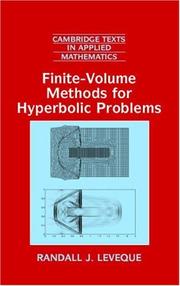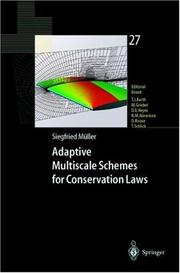| Listing 1 - 10 of 39 | << page >> |
Sort by
|

ISBN: 1107132460 113963691X 1280419504 9786610419500 0511791259 0511177690 0511042191 0511148097 0511323638 0511045077 9780511042195 9780511791253 0521810876 9780521810876 9780511045073 9780511148095 0521810876 0521009243 9780521810876 9780521009249 9781107132467 9781280419508 6610419507 9780511177699 9780511323638 Year: 2002 Publisher: Cambridge New York Cambridge University Press
Abstract | Keywords | Export | Availability | Bookmark
 Loading...
Loading...Choose an application
- Reference Manager
- EndNote
- RefWorks (Direct export to RefWorks)
This book, first published in 2002, contains an introduction to hyperbolic partial differential equations and a powerful class of numerical methods for approximating their solution, including both linear problems and nonlinear conservation laws. These equations describe a wide range of wave propagation and transport phenomena arising in nearly every scientific and engineering discipline. Several applications are described in a self-contained manner, along with much of the mathematical theory of hyperbolic problems. High-resolution versions of Godunov's method are developed, in which Riemann problems are solved to determine the local wave structure and limiters are then applied to eliminate numerical oscillations. These methods were originally designed to capture shock waves accurately, but are also useful tools for studying linear wave-propagation problems, particularly in heterogenous material. The methods studied are implemented in the CLAWPACK software package and source code for all the examples presented can be found on the web, along with animations of many of the simulations. This provides an excellent learning environment for understanding wave propagation phenomena and finite volume methods.
Book
ISBN: 9783031408601 Year: 2023 Publisher: Cham Springer Nature Switzerland :Imprint: Springer
Abstract | Keywords | Export | Availability | Bookmark
 Loading...
Loading...Choose an application
- Reference Manager
- EndNote
- RefWorks (Direct export to RefWorks)
This volume comprises the second part of the proceedings of the 10th International Conference on Finite Volumes for Complex Applications, FVCA, held in Strasbourg, France, during October 30 to November 3, 2023. The Finite Volume method, and several of its variants, is a spatial discretization technique for partial differential equations based on the fundamental physical principle of conservation. Recent decades have brought significant success in the theoretical understanding of the method. Many finite volume methods are also built to preserve some properties of the continuous equations, including maximum principles, dissipativity, monotone decay of the free energy, asymptotic stability, or stationary solutions. Due to these properties, finite volume methods belong to the wider class of compatible discretization methods, which preserve qualitative properties of continuous problems at the discrete level. This structural approach to the discretization of partial differential equations becomes particularly important for multiphysics and multiscale applications. In recent years, the efficient implementation of these methods in numerical software packages, more specifically to be used in supercomputers, has drawn some attention. The first volume contains all invited papers, as well as the contributed papers focusing on finite volume schemes for elliptic and parabolic problems. They include structure-preserving schemes, convergence proofs, and error estimates for problems governed by elliptic and parabolic partial differential equations. This volume is focused on finite volume methods for hyperbolic and related problems, such as methods compatible with the low Mach number limit or able to exactly preserve steady solutions, the development and analysis of high order methods, or the discretization of kinetic equations.

ISBN: 3540443258 9783540443254 Year: 2003 Publisher: Berlin Springer
Abstract | Keywords | Export | Availability | Bookmark
 Loading...
Loading...Choose an application
- Reference Manager
- EndNote
- RefWorks (Direct export to RefWorks)
Book
ISBN: 9535156640 9535104454 Year: 2012 Publisher: IntechOpen
Abstract | Keywords | Export | Availability | Bookmark
 Loading...
Loading...Choose an application
- Reference Manager
- EndNote
- RefWorks (Direct export to RefWorks)
We hope that among these chapters you will find a topic which will raise your interest and engage you to further investigate a problem and build on the presented work. This book could serve either as a textbook or as a practical guide. It includes a wide variety of concepts in FVM, result of the efforts of scientists from all over the world. However, just to help you, all book chapters are systemized in three general groups: New techniques and algorithms in FVM; Solution of particular problems through FVM and Application of FVM in medicine and engineering. This book is for everyone who wants to grow, to improve and to investigate.
Engineering design. --- Finite volume method. --- Numerical analysis --- Design, Engineering --- Engineering --- Industrial design --- Strains and stresses --- Design --- Computer modelling & simulation
Book
ISBN: 1282441256 9786612441257 9812834990 9789812834997 9789812834980 9812834982 Year: 2009 Publisher: Hackensack, NJ Bangalore (India) World Scientific IISc Press
Abstract | Keywords | Export | Availability | Bookmark
 Loading...
Loading...Choose an application
- Reference Manager
- EndNote
- RefWorks (Direct export to RefWorks)
The Control Volume Finite Element Method (CVFEM) is a hybrid numerical method, combining the physics intuition of Control Volume Methods with the geometric flexibility of Finite Element Methods. The concept of this monograph is to introduce a common framework for the CVFEM solution so that it can be applied to both fluid flow and solid mechanics problems. To emphasize the essential ingredients, discussion focuses on the application to problems in two-dimensional domains which are discretized with linear-triangular meshes. This allows for a straightforward provision of the key information requi
Finite element method. --- Finite volume method. --- Numerical analysis --- FEA (Numerical analysis) --- FEM (Numerical analysis) --- Finite element analysis --- Isogeometric analysis
Dissertation
Year: 2017 Publisher: Liège Université de Liège (ULiège)
Abstract | Keywords | Export | Availability | Bookmark
 Loading...
Loading...Choose an application
- Reference Manager
- EndNote
- RefWorks (Direct export to RefWorks)
Phase change materials (PCMs) are of high interest in thermal storage and thermal management applications for the earth and for space environments. Nevertheless, their functionality is intrinsically attached to phase change processes, which, from experience, it is known that they are computationally challenging. The present project arises with the intention to give a numerical solution to this problematic. A solver based on the enthalpy-porosity technique, capable to deal with diffusive-convective phase change has been adapted for OpenFOAM 4.1. For the implementation of the enthalpy technique, the work of Voller Mushy has been closely followed, and a detailed explanation of the equations employed and the assumptions that support them is given. Furthermore, the numerical approach is also specified, with a close attention to the discretization process based on the Finite Volume Method (FVM). The solver algorithm is provided with a deep explanation of its implementation in OpenFOAM. Furthermore, an analysis of the convergence of the numerical solution is provided. Moreover, the works of several authors, have been employed to help in some aspects of the implementation and validation of the solver. As part of this validation, the controversial case of the melting of pure Gallium in a rectangular cavity is computed with the OpenFOAM solver. The author gives some discussion about the results obtained and compares them with the existing literature in order to assess the accuracy of the mathematical model employed. The last part of the project employs the customize solver to analyze the thermal behaviour of a PCM during melting. Three different cases are proposed and tested for two different geometries: one under gravity conditions, where natural convection is part of the heat transfer process, and another two independent of gravity or proper of micro-gravity environments: a pure conductive case and a case with Bénard-Marangoni convection.
Book
ISBN: 9783642051340 9783642051333 Year: 2010 Publisher: Berlin, Heidelberg Springer Berlin Heidelberg
Abstract | Keywords | Export | Availability | Bookmark
 Loading...
Loading...Choose an application
- Reference Manager
- EndNote
- RefWorks (Direct export to RefWorks)
This book on numerical methods for singular perturbation problems - in particular, stationary reaction-convection-diffusion problems exhibiting layer behaviour is devoted to the construction and analysis of layer-adapted meshes underlying these numerical methods. A classification and a survey of layer-adapted meshes for reaction-convection-diffusion problems are included. This structured and comprehensive account of current ideas in the numerical analysis for various methods on layer-adapted meshes is addressed to researchers in finite element theory and perturbation problems. Finite differences, finite elements and finite volumes are all covered.
Mathematics. --- Numerical Analysis. --- Ordinary Differential Equations. --- Partial Differential Equations. --- Differential Equations. --- Differential equations, partial. --- Numerical analysis. --- Mathématiques --- Analyse numérique --- Finite volume method. --- Reaction-diffusion equations.
Book
ISBN: 9780128128374 0128128372 0128127791 9780128127797 Year: 2018 Publisher: London, United Kingdom : Academic Press, an imprint of Elsevier,
Abstract | Keywords | Export | Availability | Bookmark
 Loading...
Loading...Choose an application
- Reference Manager
- EndNote
- RefWorks (Direct export to RefWorks)
Book
ISBN: 3030946363 3030946355 Year: 2022 Publisher: Cham, Switzerland : Springer,
Abstract | Keywords | Export | Availability | Bookmark
 Loading...
Loading...Choose an application
- Reference Manager
- EndNote
- RefWorks (Direct export to RefWorks)
Finite volume method. --- Navier-Stokes equations. --- Equations, Navier-Stokes --- Differential equations, Partial --- Fluid dynamics --- Viscous flow --- Numerical analysis --- Equacions de Navier-Stokes --- Navier-Stokes (Equacions) --- Dinàmica de fluids --- Equacions en derivades parcials
Book
ISBN: 3642051537 3642051332 9786613569530 3642051340 1280391618 Year: 2010 Publisher: Berlin : Springer,
Abstract | Keywords | Export | Availability | Bookmark
 Loading...
Loading...Choose an application
- Reference Manager
- EndNote
- RefWorks (Direct export to RefWorks)
This book on numerical methods for singular perturbation problems - in particular, stationary reaction-convection-diffusion problems exhibiting layer behaviour is devoted to the construction and analysis of layer-adapted meshes underlying these numerical methods. A classification and a survey of layer-adapted meshes for reaction-convection-diffusion problems are included. This structured and comprehensive account of current ideas in the numerical analysis for various methods on layer-adapted meshes is addressed to researchers in finite element theory and perturbation problems. Finite differences, finite elements and finite volumes are all covered.
Reaction-diffusion equations --- Finite volume method --- Mathematics --- Engineering & Applied Sciences --- Applied Mathematics --- Calculus --- Mathematical Theory --- Physical Sciences & Mathematics --- Reaction-diffusion equations. --- Finite volume method. --- Diffusion-reaction equations --- Equations, Reaction-diffusion --- Mathematics. --- Differential equations. --- Partial differential equations. --- Numerical analysis. --- Numerical Analysis. --- Ordinary Differential Equations. --- Partial Differential Equations. --- Mathematical analysis --- Partial differential equations --- 517.91 Differential equations --- Differential equations --- Math --- Science --- Numerical analysis --- Differential equations, Parabolic --- Differential Equations. --- Differential equations, partial.
| Listing 1 - 10 of 39 | << page >> |
Sort by
|

 Search
Search Feedback
Feedback About UniCat
About UniCat  Help
Help News
News